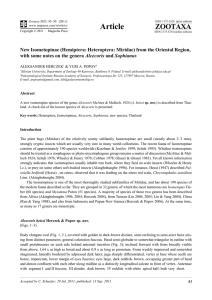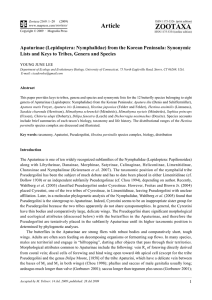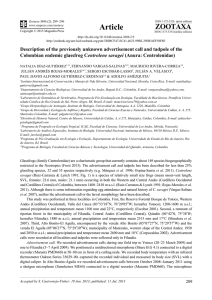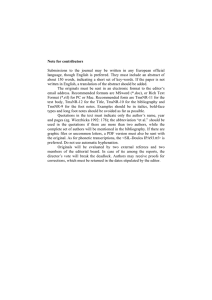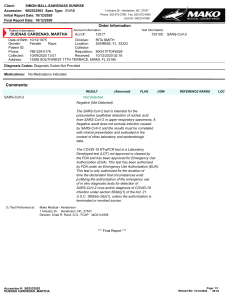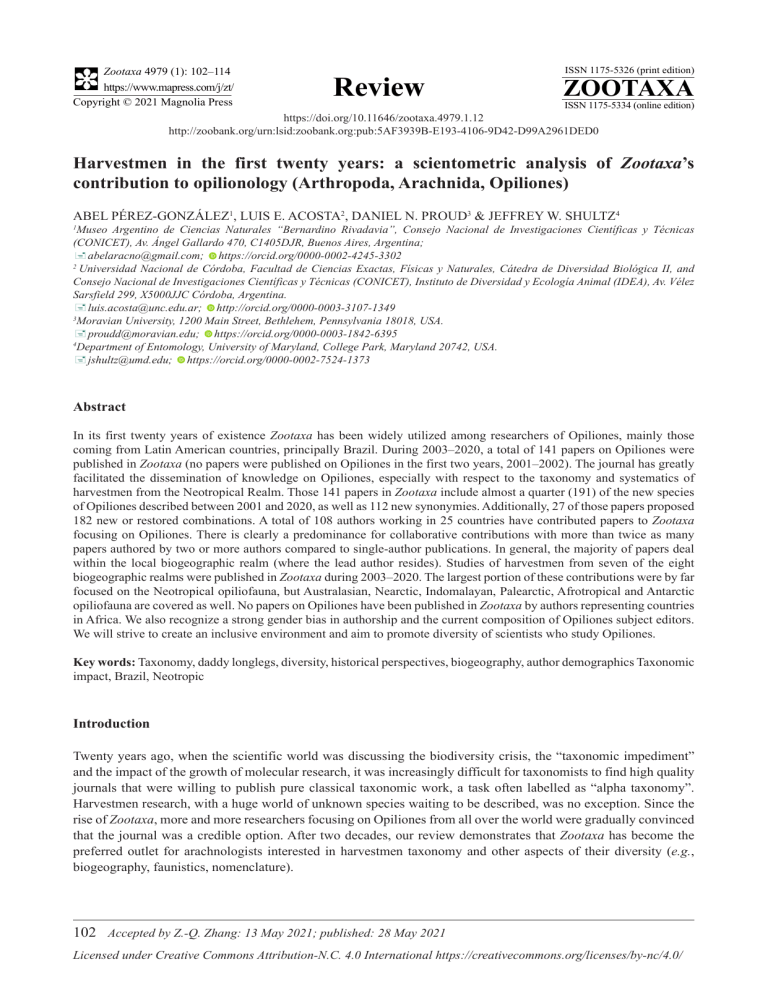
Zootaxa 4979 (1): 102–114 https://www.mapress.com/j/zt/ Copyright © 2021 Magnolia Press Review ISSN 1175-5326 (print edition) ZOOTAXA ISSN 1175-5334 (online edition) https://doi.org/10.11646/zootaxa.4979.1.12 http://zoobank.org/urn:lsid:zoobank.org:pub:5AF3939B-E193-4106-9D42-D99A2961DED0 Harvestmen in the first twenty years: a scientometric analysis of Zootaxa’s contribution to opilionology (Arthropoda, Arachnida, Opiliones) ABEL PÉREZ-GONZÁLEZ1, LUIS E. ACOSTA2, DANIEL N. PROUD3 & JEFFREY W. SHULTZ4 Museo Argentino de Ciencias Naturales “Bernardino Rivadavia”, Consejo Nacional de Investigaciones Científicas y Técnicas (CONICET), Av. Ángel Gallardo 470, C1405DJR, Buenos Aires, Argentina; � abelaracno@gmail.com; https://orcid.org/0000-0002-4245-3302 2 Universidad Nacional de Córdoba, Facultad de Ciencias Exactas, Físicas y Naturales, Cátedra de Diversidad Biológica II, and Consejo Nacional de Investigaciones Científicas y Técnicas (CONICET), Instituto de Diversidad y Ecología Animal (IDEA), Av. Vélez Sarsfield 299, X5000JJC Córdoba, Argentina. � luis.acosta@unc.edu.ar; http://orcid.org/0000-0003-3107-1349 3 Moravian University, 1200 Main Street, Bethlehem, Pennsylvania 18018, USA. � proudd@moravian.edu; https://orcid.org/0000-0003-1842-6395 4 Department of Entomology, University of Maryland, College Park, Maryland 20742, USA. � jshultz@umd.edu; https://orcid.org/0000-0002-7524-1373 1 Abstract In its first twenty years of existence Zootaxa has been widely utilized among researchers of Opiliones, mainly those coming from Latin American countries, principally Brazil. During 2003–2020, a total of 141 papers on Opiliones were published in Zootaxa (no papers were published on Opiliones in the first two years, 2001–2002). The journal has greatly facilitated the dissemination of knowledge on Opiliones, especially with respect to the taxonomy and systematics of harvestmen from the Neotropical Realm. Those 141 papers in Zootaxa include almost a quarter (191) of the new species of Opiliones described between 2001 and 2020, as well as 112 new synonymies. Additionally, 27 of those papers proposed 182 new or restored combinations. A total of 108 authors working in 25 countries have contributed papers to Zootaxa focusing on Opiliones. There is clearly a predominance for collaborative contributions with more than twice as many papers authored by two or more authors compared to single-author publications. In general, the majority of papers deal within the local biogeographic realm (where the lead author resides). Studies of harvestmen from seven of the eight biogeographic realms were published in Zootaxa during 2003–2020. The largest portion of these contributions were by far focused on the Neotropical opiliofauna, but Australasian, Nearctic, Indomalayan, Palearctic, Afrotropical and Antarctic opiliofauna are covered as well. No papers on Opiliones have been published in Zootaxa by authors representing countries in Africa. We also recognize a strong gender bias in authorship and the current composition of Opiliones subject editors. We will strive to create an inclusive environment and aim to promote diversity of scientists who study Opiliones. Key words: Taxonomy, daddy longlegs, diversity, historical perspectives, biogeography, author demographics Taxonomic impact, Brazil, Neotropic Introduction Twenty years ago, when the scientific world was discussing the biodiversity crisis, the “taxonomic impediment” and the impact of the growth of molecular research, it was increasingly difficult for taxonomists to find high quality journals that were willing to publish pure classical taxonomic work, a task often labelled as “alpha taxonomy”. Harvestmen research, with a huge world of unknown species waiting to be described, was no exception. Since the rise of Zootaxa, more and more researchers focusing on Opiliones from all over the world were gradually convinced that the journal was a credible option. After two decades, our review demonstrates that Zootaxa has become the preferred outlet for arachnologists interested in harvestmen taxonomy and other aspects of their diversity (e.g., biogeography, faunistics, nomenclature). 102 Accepted by Z.-Q. Zhang: 13 May 2021; published: 28 May 2021 Licensed under Creative Commons Attribution-N.C. 4.0 International https://creativecommons.org/licenses/by-nc/4.0/ A taxonomic journal that lacks page charges is highly valued by the international community of taxonomists, especially those from developing countries with limited access to the funds required to support open-access publications. At the same time, these countries often represent, paradoxically, regions with the highest undiscovered biodiversity on the planet. This could be the reason for the “meteoric” success of Zootaxa in regions like Latin America. However, despite the “obvious” fact that taxonomy is fundamental to other fields of biology, the crude reality is that taxonomy and taxonomic journals still receive little global recognition, based upon prejudiced and tendentious “impact metrics”. This reality was recently exposed when Clarivate Analytics suppressed Zootaxa from the Journal Citation Report (JCR) for 2019 (2020 release), allegedly because of an excess of journal self-citation rates, a decision later reversed in the middle of worldwide Zootaxa-support campaigns. The attempt to suppress the leading journal in zoological taxonomy not only highlighted the flaws of the citation analysis metrics and algorithms, including the Journal Impact Factor (JIF), but also the global tendency to undervalue taxonomy. To help reverse this alarming trend, it is important that taxonomists themselves begin to demonstrate, with explicit scientometric data, the real impact of taxonomic work. The goal is to bring attention to taxonomy as a fundamental science, and to properly acknowledge the value of taxonomic journals and their scientific contributions. The present paper aims to provide a quantitative overview of the magnitude of Zootaxa’s influence on the study of Opiliones, the third largest arachnid order after spiders and Acari. We compiled data for all papers published in the journal focusing on harvestmen between 2001–2020 including the taxonomic changes proposed, geographic scope of the work, and information about the authors who contributed the work. These data were analyzed using a scientometric approach, and illustrated using charts and maps. Material and methods Several sources were used to compile the data for the published papers and species: Zootaxa’s web page “search” option (https://www.mapress.com/j/zt/); the Zoological Record (via Zhi-Qiang Zhang and Gonzalo Giribet); Google Scholar; the records of each subject editor; and the abstracts of published articles. The number of citations of each paper were obtained by the freely accessible search engine “Google Scholar” (https://scholar.google.com/ schhp?hl=en-US). All information was tabulated in Excel. Graphs were constructed using Excel, Corel Draw, or the R (R Core Team 2020) package ggplot2 (Wickham 2016). Images of specific researchers were obtained from the internet, mostly from the OmniPaper Project web page (Kury 2003) or provided by the researcher. Permission was obtained from these researchers for image use. The map of the world biogeographic realms was obtained from https://es.wikipedia.org/wiki/Ecozona#/media/Archivo:Ecozones.svg (Licence CC BY-SA 3.0). Refer to the electronic PDF version for color figures. Results Number of papers on Opiliones: The first Zootaxa paper was released on 28 May 2001, but it was not until 17 January 2003 that the first contribution on Opiliones was published in Volume 133, No. 1. This paper, entitled “A new Rakaia species (Opiliones, Cyphophthalmi, Pettalidae) from Otago, New Zealand” and authored by Sarah L. Boyer and Gonzalo Giribet, constitutes a major milestone. It was the first of 141 papers (totaling 2479 pages) published in Zootaxa between 2003–2020 that focused on harvestmen. The rate of Opiliones publications has varied considerably during those 17 years. There was a relatively slow start, with only eight papers on Opiliones appearing in the first three years (2003 to 2005). The first notable surge in publications occurred when Peter Jäger, Peter Schwendinger and Martin Päckert (2006) edited a special volume (“Festschrift”) to celebrate the 65th birthday of the renowned German ornithologist and opilionologist Prof. Dr. Jochen Martens. The volume was published on 28 September 2006 and contained nine papers on Opiliones written by 13 authors from North and Latin America, Europe and Japan. After that initial surge, there were several years with very few Opiliones publications (e.g., 2007, 2010 and 2019 with three, four and three papers, respectively) but also a remarkable year in which the number of publications peaked (i.e., 2012 with 18 papers). The annual rate of publication was higher on average between 2011 and 2020 (13.8 papers per year) compared to 2003–2010 (6.6 papers per year). The period from 2011 to 2018 was particularly active with 87 papers (15.5 papers per year) representing 62% of all papers published between 2003 and 2020 (Fig.1). A small proportion of the 141 papers were published as open access (12 papers, 8.5% of the total). HARVESTMEN IN ZOOTAXA’S FIRST TWENTY YEARS Zootaxa 4979 (1) © 2021 Magnolia Press · 103 Seven of the open access papers were submitted by corresponding authors based in the USA, whereas only two open access papers were published by one author from a Latin American country (Brazil). This statistic clearly shows that open access was not a feasible option for most authors that have published papers on Opiliones in Zootaxa between 2003 and 2020 which is likely connected to the extremely limited funding for publishing that is available to these authors. FIGURE 1. Number of papers focusing on Opiliones published in Zootaxa between 2003 and 2020. There is a clear predominance for collaborative contributions with more than twice as many papers authored by two or more authors (n=96) compared to single-author publications (n=45). The number of collaborative papers was higher than the number of single author papers in all years, except in 2004 when all contributions (n=2) were single-authored and in 2006 and 2008 when the number of single-author papers was equal to the number of collaborative papers. Citation impact: Of the 141 papers published between 2003 and 2020, 129 were cited at least once. These 141 papers received 1401 citations, resulting in a mean of 9.9 citations per paper. However, the 10 most-cited articles (Table 1) comprise around one third of all citations, such that the mean number of citations for most papers is lower (mean of 7.2 citations per paper for 131 papers). The taxonomic nature of the majority of these articles likely explains the low citation rate, and indicates that a standard citation index may fail as an objective measure of the impact/value of taxonomy-based scientific contributions. Table 1. The ten most cited papers on harvestmen published in Zootaxa between 2003 and 2020 were cited a total of 452 times. No. citations Article 98 Kury, A.B. (2013) Order Opiliones Sundevall, 1833. In: Zhang, Z.-Q. (Ed.), Animal Biodiversity: An Outline of Higher-level Classification and Survey of Taxonomic Richness (Addenda 2013). Zootaxa, 3703 (1), 27–33. 65 Kury, A.B. & Medrano, M. (2016) Review of terminology for the outline of dorsal scutum in Laniatores (Arachnida, Opiliones). Zootaxa, 4097 (1), 130–134. ...Continued on the next page 104 · Zootaxa 4979 (1) © 2021 Magnolia Press PÉREZ-GONZÁLEZ ET AL. Table 1. (Continued) No. citations Article 62 Schoenhofer, A.L. (2013) A taxonomic catalogue of the Dyspnoi Hansen and Sørensen, 1904 (Arachnida: Opiliones). Zootaxa, 3679 (1), 1–68. 41 Kury, A.B. (2011) Order Opiliones Sundevall, 1833. In: Zhang, Z.-Q.(Ed.), Animal biodiversity: An outline of higher-level classification and survey of taxonomic richness. Zootaxa, 3148 (1), 112–114. 37 Hara, M.R. & Pinto-da-Rocha, R. (2010) Systematic review and cladistic analysis of the genus Eusarcus Perty 1833 (Arachnida, Opiliones, Gonyleptidae). Zootaxa, 2698 (1), 1–136. 34 Townsend Jr., V.R., Viquez, C., Vanzandt, P.A. & Proud, D.N. (2010) Key to the species of Cosmetidae (Arachnida, Opiliones) of Central America, with notes on penis morphology and sexual dimorphisms. Zootaxa, 2414 (1), 1–26. 31 Kury, A.B. (2016) A classification of the penial microsetae of Gonyleptoidea (Opiliones: Laniatores). Zootaxa, 4179 (1), 144–150. 29 Novak, T., Delakorda, S.L. & Novak, L.S. (2006) A review of harvestmen (Arachnida: Opiliones) in Slovenia. Zootaxa, 1325 (1), 267–276. 28 Taylor, C.K. (2011) Revision of the genus Megalopsalis (Arachnida: Opiliones: Phalangioidea) in Australia and New Zealand and implications for phalangioid classification. Zootaxa, 2773 (1), 1–65. 27 Kury, A.B. & Alonso-Zarazaga, M.A. (2011) Addenda and corrigenda to the “Annotated catalogue of the Laniatores of the New World (Arachnida, Opiliones)”. Zootaxa, 3034 (1), 47–68. Subjects covered and taxonomic/nomenclatural impact: With respect to their contribution to opilionology, 113 papers (80.1%) focused mainly on taxonomy and/or systematics while the remainder focused on topics such as biogeography, morphology, faunistics, etc. (Fig. 2). Additionally three of the published catalogues (Schönhofer 2013; Kury & Alonso-Zarazaga 2011; Sharma et al. 2011) also included a large amount of new taxonomic and systematic information. FIGURE 2. Primary focus of the papers published in Zootaxa 2003–2020 related to Opiliones (n=141). The majority of papers (n=113, 80.1%) focused mainly on taxonomy and/or systematics. HARVESTMEN IN ZOOTAXA’S FIRST TWENTY YEARS Zootaxa 4979 (1) © 2021 Magnolia Press · 105 A closer analysis of the 113 papers containing taxonomic contributions (Fig. 3) revealed that 191 new species were described in 99 papers. Additionally, 16 papers included descriptions of 21 new genera, and in four papers four new subfamilies and one new family of Opiliones were established. Of course, the taxonomic contributions of the 2003–2020 Zootaxa papers on Opiliones were not limited to the description of new taxa. It is worth noting that eight papers proposed 18 nomina nova (replacement names), 11 papers included designations of 5 neotypes and 10 lectotypes, 30 papers introduced 112 new synonymies, 27 papers proposed 182 new or restored combinations, 11 papers comprised 23 removals from synonymy (revalidations) and six papers included 23 proposals of new ranks. In addition, 35 papers provided 70 redescriptions or complementary descriptions, 22 papers included 32 emended diagnoses, 29 papers included identification keys, 22 papers contained phylogenetic analyses and 5 papers provided DNA sequences. FIGURE 3. Nomenclatural acts proposed in Zootaxa papers (2003–2020). Numbers indicate the absolute number of acts corresponding to each category. Comparison with other journals: To understand the taxonomic impact of Zootaxa from a global perspective, we contrasted the new species of Opiliones described in Zootaxa with those described in other journals or books (in this case considering the period 2001-2020). A total of 775 new species of Opiliones were described in 85 journals and books from 2001 to 2020. Of those, 191 new species (24.4%) of Opiliones were published in Zootaxa (Fig. 4). The contribution of Zootaxa was more than double that of the journal with the second highest number of new species described during this time (Invertebrate Systematics, 74 new spp.). Ten journals/books (including Zootaxa) accounted for 66.2% (513 new species) of all new species published and approximately half of the journals/books (44) described only one or two new species between 2001 and 2020. We also analyzed the number of new species described per year in Zootaxa compared to other journals (Fig. 5). In most years, the number of new species described in Zootaxa was lower than the number described in all other journals/books combined. However, 2012 was an exceptional year in which more than twice as many new species of Opiliones were described in Zootaxa compared to other sources. In the last decade (2011–2020), the proportion of new species published in Zootaxa compared to other journals and books was higher (33.2%) than the proportion in the entire period under study (24.4%). This is a clear indication that Zootaxa has become a preferred avenue for Opiliones researchers to publish descriptions of new species in the last decade. 106 · Zootaxa 4979 (1) © 2021 Magnolia Press PÉREZ-GONZÁLEZ ET AL. FIGURE 4. Cumulative number of new harvestmen species described in the period 2001–2020, and contribution of each journal or book arranged in decreasing order. A color legend is shown for nine sources contributing the largest number of new species. FIGURE 5. The number of new species of Opiliones described each year in Zootaxa compared to 84 other journals and books combined. Of the 783 new species of Opiliones described worldwide between 2001 and 2020, 191 (24.4%) new species were described in Zootaxa. HARVESTMEN IN ZOOTAXA’S FIRST TWENTY YEARS Zootaxa 4979 (1) © 2021 Magnolia Press · 107 Geographic coverage of papers: Harvestmen from seven of the eight biogeographic realms were addressed in Zootaxa (2003–2020). Slightly more than half of all papers on Opiliones in Zootaxa during this time focused on the Neotropical opiliofauna (71 papers) (Fig. 6). In contrast, only five papers were published on the diverse Afrotropical opilionids (Fig. 6). To examine this asymmetry, we compared the number of new species described per realm. There were an astonishing 104 new species described from the Neotropical realm, representing more than half of all new species. In addition, 26 new species were described from the Australasian realm, 20 new species from the Nearctic realm, 20 new species from the Indomalayan realm, 14 new species from the Palearctic, and only 7 new species from the Afrotropical realm. The sole paper published on harvestmen from the Antarctic realm (Fig. 6) was a redescription of Promecostethus unifalculatus Enderlein, 1909, by Porto & Pérez González (2020) in Volume 4861, No. 1. This remarkable harvestman does not inhabit the Antarctic continent, where Opiliones are almost certainly absent, but rather the Antarctic Crozet Islands, which exhibit more mesic climatic conditions. FIGURE 6. Number of papers on Opiliones from each biogeographic realm published in Zootaxa (2003–2020). For example, 5 papers focused on Opiliones from the Afrotropical Realm. Most contributing authors and collaboration: A total of 108 authors have contributed to the 141 papers on Opiliones in the first 20 years of Zootaxa. The two most prolific authors were the Brazilian arachnologists Adriano B. Kury and Ricardo Pinto-da-Rocha, with 32 and 26 papers, respectively (Fig. 7). These two authors share only a single co-authored paper and thus have contributed a combined total of 57 papers (40.4%). In contrast, 85 authors have participated in one or two papers. Greater asymmetry emerges between male and female authors with only 23 female authors having published papers on Opiliones in Zootaxa compared to 85 males (Fig. 8). Collaborative contributions clearly predominate, with more than twice as many papers written by two or more authors (n=96) compared to single-author publications (n=45). The number of collaborative papers was higher than the number of single-author papers in all years except 2004, when all contributions (n=2) were single-authored, and 2006 and 2008, when the number of single-author papers was equal to the number of collaborative papers (Fig. 1). In terms of collaborative works, 99 of the 108 authors have published at least one paper in Zootaxa with a co-author. The two most prolific authors (Fig. 7) also exhibit the highest number of total collaborations (measured as number of paired interactions such that the same pair of co-authors may be counted multiple times); Ricardo Pinto-da-Rocha had 33 total interactions with coauthors and Adriano Kury had 24 (Fig. 8). These authors also have the highest number of unique interactions (measured as the number of interactions with different coauthors such that the same pair of co-authors is only counted once). However, the rankings are inverted; Adriano Kury had 20 unique interactions with coauthors whereas Ricardo Pinto-da-Rocha had 18 (Fig. 8). For the 96 papers with more than one author, there were a total of 175 interactions between two different authors; most of the interactions between coauthors occurred only once while 18 pairs of coauthors interacted two to three times (Fig. 9). Brazilian 108 · Zootaxa 4979 (1) © 2021 Magnolia Press PÉREZ-GONZÁLEZ ET AL. arachnologists Ricardo Pinto-da-Rocha and Marcos Ryotaro Hara were the most frequent pair of collaborators, sharing coauthorship seven times followed by the pair of Chinese arachnologists Chao Zhang and Feng Zhang who shared coauthorship six times (Fig. 9). FIGURE 7. Authors with the greatest number of papers on Opiliones published in Zootaxa between 2003 and 2020. Geographic coverage by author’s country: Authors working at institutions based in 25 different countries have contributed papers on Opiliones to Zootaxa. Most contributions were made by authors based in Brazil and the United States of America, with 35 and 21 total (not necessarily unique) authors, respectively. Their contributions were remarkably more voluminous than the rest of the countries, where the majority only contributed one (10 countries) or two (7 countries) papers (Fig. 10). In general, we observed a propensity for “endogenous contributions” where most papers deal with the same biogeographic realm in which the lead author and their institution reside. Nevertheless, there is also a remarkable number of “exogenous contributions” (authors covering taxa from different biogeographic realms than their own) (Fig. 11). As an example, contributions by South American authors focus largely on the Neotropical realm; however, there are also a few papers dealing with faunas from the Australasian, Indomalayan and Afrotropical realms, and, in one case, even Antarctic harvestmen. In a similar way, North American authors were responsible for all papers dealing with the Nearctic fauna, but they also made important contributions to the Autralasian opiliofauna and to a lesser extent the Neotropical, Indomalayan and Afrotropical realms. European authors focused mostly on the Palearctic fauna, but also made contributions to the Indomalayan, Afrotropical and Neotropical realms. Authors from Australia contributed to their own biogeographical realm but also produced one paper on the Afrotropical fauna. The most endogenous production comes from countries in eastern Asia (China, Japan and Taiwan) with papers about harvestmen from the Palearctic and Indomalayan realms (both present in China). No author based in a country in Africa was responsible for a paper on Opiliones published in Zootaxa up to to 2020. HARVESTMEN IN ZOOTAXA’S FIRST TWENTY YEARS Zootaxa 4979 (1) © 2021 Magnolia Press · 109 FIGURE 8. Authors with the greatest number of interactions with coauthors. Total number of interactions with coauthors (red bars, top) and number of unique interactions between pairs of coauthors (blue bars, bottom). FIGURE 9. Frequency of interactions between each pair of coauthors (i.e. how many times two people coauthored a paper together). Most interactions between coauthors occur only once while few interactions have occurred between 2–7 times. Photos are shown for the most frequent interactions between pairs of coauthors. 110 · Zootaxa 4979 (1) © 2021 Magnolia Press PÉREZ-GONZÁLEZ ET AL. FIGURE 10. Comparative overview of the contributions of different countries to the published papers on Opiliones in Zootaxa (2001–2020). The count is based on the institutional affiliation(s) declared by authors in each paper. If an author listed institutional affiliations in two different countries then both countries were counted. There are a total of 111 country affiliations for 108 authors. Subject editors: For the first few years, Zootaxa had no designated subject editor for Opiliones. Instead, all manuscripts for this arachnid order were managed and accepted by Peter Jäger (Germany) who served as Editor for Arachnida excl. Acari from 2002 to 2005. During this period, Peter was responsible for the editorial work of the first eight papers. In 2005, Peter J. Schwendinger (Switzerland) joined the Zootaxa editorial team as the first Subject Editor for Opiliones. In 2006, Peter Schwendinger and Peter Jäger were responsible for efforts that led to the first “surge” of harvestmen papers in Zootaxa by editing the Opiliones papers included in the Festschrift for Jochen Martens (Jäger et al. 2006). From 2007 to 2009, editorial work on Opiliones manuscripts also benefited from the help of some external subject editors. In this period, Mark L. I. Judson edited five manuscripts on Opiliones, and Alain Dubois edited one. Also at this time, Peter Jäger edited a multitaxon manuscript that contained information on Opiliones among other orders of Arachnida. In 2011 and 2013, Zootaxa’s Editor-in-Chief, Zhi-Qiang Zhang edited two manuscripts on Opiliones, as a part of two special issues of Zootaxa on animal biodiversity and higher classification (Zhang 2011, 2013). In 2009, Abel Pérez-González (Cuba; working originally in Brazil, currently in Argentina) became the second subject editor for Opiliones, followed by Axel Schönhofer (Germany) in 2010, Jeffrey W. Shultz (U.S.A.) in 2014, Luis E. Acosta (Argentina) in 2016, and Daniel N. Proud (U.S.A.) in 2020. Axel Schönhofer served as a subject editor until 2014; the remaining five are serving as subject editors at present (Table 2). In total, 120 manuscripts were accepted by the Opiliones subject editors from 2003 to 2020. From this total Abel Pérez-González was responsible for 57 manuscripts, followed by Peter Schwendinger with 27, Luis E. Acosta with 13, Axel Schönhofer with 12 and Jeffrey W. Shultz with 11. Daniel N. Proud edited his first manuscript in 2021, i.e., after the period covered in the present scientometric analysis for the first 20 years of Zootaxa. HARVESTMEN IN ZOOTAXA’S FIRST TWENTY YEARS Zootaxa 4979 (1) © 2021 Magnolia Press · 111 Table 2. A chronological overview of all Zootaxa Subject Editors on Opiliones (2003–2020), with an indication of the taxonomic coverage. Subject-Editor Timeline (taxonomic subjects) Peter Jäger 2002–2005 (Arachnida excl. Acari) Peter J. Schwendinger 2005–2009 (Opiliones) 2009–2010 (Opiliones excl. Laniatores) 2011–present (Opiliones: Cyphophthalmi) Abel Pérez-González 2009–2016 (Opiliones: Laniatores) 2016–present (Opiliones: Laniatores: non-Gonyleptoidea) Axel Schönhofer 2010–2014 (Opiliones: Dyspnoi & Eupnoi) Jeffrey W. Shultz 2014–present (Opiliones: Dyspnoi & Eupnoi) Luis E. Acosta 2016–2019 (Opiliones: Laniatores: Gonyleptoidea) 2019–present (Opiliones: Laniatores: Gonyleptidae and other Gonyleptoidea) Daniel N. Proud 2020–present (Opiliones: Laniatores: Cosmetidae and other Gonyleptoidea) FIGURE 11. Number of papers produced in each country where the lead author was based and grouped by continents (Americas were divided into three regions: 1. North America, 2. Central America and the Caribbean, 3. South America). Line widths are proportional to the number of contributions focusing on taxa in a particular biogeographic realm. UK: United Kingdom, USA: United States of America. The increasing amount of editorial work related to Opiliones triggered the expansion of subject editors over time, so the participation did not remain homogeneous in the 2003-2020 period and “evolved” accordingly (Fig. 12). Peter Schwendinger concentrated his highest volume of editorial work in the “early days”, mainly between 2006 and 2011, while for Abel Perez-González, who took the responsibility of the Laniatores, the highest volume of edited manuscripts occurred during 2011-2018. Axel Schönhofer made important contributions editing manuscripts on Dyspnoi & Eupnoi from 2011 to 2014, and was replaced by Jeffrey W. Shultz who edited 11 accepted manuscripts from 2015 to 2018. As manuscripts on Laniatores continued to increase, the editorial work on Gonyleptoidea was undertaken in 2016 by Luis E. Acosta. Given the diversity of Gonyleptoidea, the editorial work for this group was further divided in 2020, and part of it is now handled by Daniel N. Proud. The acceptance rate of manuscripts on Opiliones submitted to Zootaxa was very high and the majority of papers submitted successfully reached final publication. The rejection rate (including withdrawn manuscripts) was estimated to be 13.4% based on 139 manuscripts processed by Subject Editors Peter Jäger, Peter Schwendinger, Abel Pérez-González, Jeffrey W. Shultz and Luis E. Acosta during the period 2003–2020. 112 · Zootaxa 4979 (1) © 2021 Magnolia Press PÉREZ-GONZÁLEZ ET AL. FIGURE 12. A total of 141 papers were accepted by nine subject editors between 2003 and 2020. Diversity and inclusion: It is important to recognize the strong gender bias of the Zootaxa Opiliones editorial staff over the past 20 years, where no female has hitherto served in this role. We are committed to creating a diverse and inclusive environment, and we sincerely hope to recruit greater diversity into our editorial team in the near future. We also want to encourage authors from underrepresented regions of the world to publish in Zootaxa. We are particularly interested in increasing the number of Zootaxa contributions by Opiliones researchers from African countries. Conclusion In the first 20 years of existence, Zootaxa has been widely embraced among researchers on Opiliones and has quickly become the leading taxonomical journal among opilionologists. This is especially true for researchers from Latin American countries, particularly Brazil. The 141 papers on Opiliones published in Zootaxa (2003–2020) have greatly impacted our collective understanding of the taxonomy and systematics of harvestmen. Zootaxa has become the most important journal in Opiliones taxonomy and has published almost a quarter of all the new harvestman species described during the last 20 years. This impact is higher, reaching a third of all new species, over the last 10 years. There is still much work to be done in terms of understanding the diversity of Opiliones worldwide. Our analysis of the past 20 years of Zootaxa contributions indicates that this journal has become an important tool for taxonomic and systematic work on Opiliones, and we are confident that it will continue to positively impact the field in the future. Acknowledgements We thank Ana Laura Carbajal de la Fuente for valuable support in data processing and graphics design, as well as insightful feedback about the manuscript structure. We thank Zhi-Qiang Zhang and Gonzalo Giribet for providing HARVESTMEN IN ZOOTAXA’S FIRST TWENTY YEARS Zootaxa 4979 (1) © 2021 Magnolia Press · 113 data from the Zoological Record. Willians Porto and Vanesa Mamani helped in the compilation of harvestmen species described in all journals between 2001–2020. Chao Zhang kindly answered many questions and provided useful pictures. We thank Louise Keegan, Peter Jäger, and Zhi-Qiang Zhang for reviewing the manuscript and providing corrections and feedback. This article is dedicated to all the reviewers whose hard work has contributed decisively to improving and enriching the manuscripts. This contribution is also dedicated to our colleagues Peter Schwendinger and Axel Schönhofer in recognition of their dedicated work as Zootaxa subject editors for Opiliones. References Enderlein, G. (1909) Die Spinnen der Crozet-Inseln und von Kerguelen. In: Drygalski, E. von (Ed.), Deutsche SüdpolarExpedition 1901–1903. Georg Reimer, Berlin, pp. 535–540. Jäger, P., Päckert, M. & Schwendinger, P. (2006) Ornithology, Arachnology and Asian Mountain Ranges—A Tribute to the Work of Prof. Dr Jochen Martens. Zootaxa, 1325, 1–384. https://doi.org/10.11646/zootaxa.1325.1 Kury, A.B. (2003 onwards) OmniPaper Project — The ARACNOLAB internet resource on Opilionological Taxonomic Literature. Museu Nacional/UFRJ website. Available from: http://www.museunacional.ufrj.br/mndi/Aracnologia/pdfliteratura/ pdfs%20opiliones.htm (accessed 30 April 2021) Kury, A.B. & Alonso-Zarazaga, M.A. (2011) Addenda and corrigenda to the “Annotated catalogue of the Laniatores of the New World (Arachnida, Opiliones)”. Zootaxa, 3034 (1), 47–68. https://doi.org/10.11646/zootaxa.3034.1.3 R Core Team (2020) R: A language and environment for statistical computing. R Foundation for Statistical Computing, Vienna, Austria. https://www.R-project.org/. Schoenhofer, A.L. (2013) A taxonomic catalogue of the Dyspnoi Hansen and Sørensen, 1904 (Arachnida: Opiliones). Zootaxa, 3679 (1), 1–68. https://doi.org/10.11646/zootaxa.3679.1.1 Sharma, P., Kury, A.B. & Giribet, G. (2011) The Zalmoxidae (Arachnida: Opiliones: Laniatores) of the Paleotropics: a catalogue of Southeast Asian and Indo-Pacific species. Zootaxa, 2972, 37–58. https://doi.org/10.11646/zootaxa.2972.1.3 Porto, W. & Pérez-González, A. (2020) Redescription of Promecostethus unifalculatus, the only known harvestman from Crozet Islands (Opiliones: Triaenonychidae). Zootaxa, 4861 (1), 120–130. https://doi.org/10.11646/zootaxa.4861.1.8 Wickham, H. (2016) ggplot2: Elegant Graphics for Data Analysis. Springer-Verlag, New York, 260 pp. https://doi.org/10.1007/978-3-319-24277-4 Zhang, Z.Q. (Ed.) (2011) Animal biodiversity: An outline of higher-level classification and survey of taxonomic richness. Zootaxa, 3148, 1–237. https://doi.org/10.11646/zootaxa.3148.1 Zhang, Z.Q. (Ed.) (2013) Animal Biodiversity: An Outline of Higher-level Classification and Survey of Taxonomic Richness (Addenda 2013). Zootaxa, 3703, 1–82. https://doi.org/10.11646/zootaxa.3703.1 114 · Zootaxa 4979 (1) © 2021 Magnolia Press PÉREZ-GONZÁLEZ ET AL.
